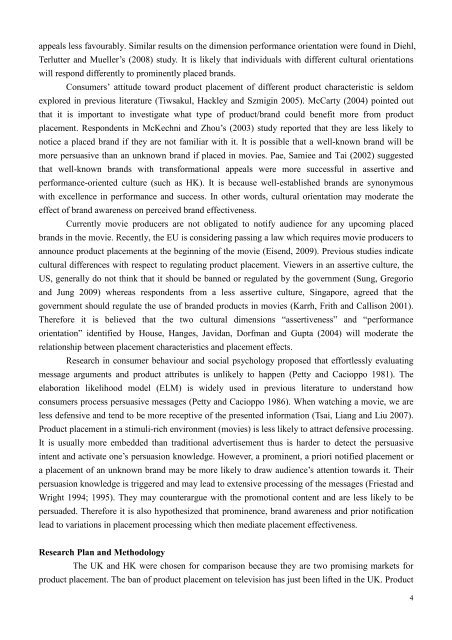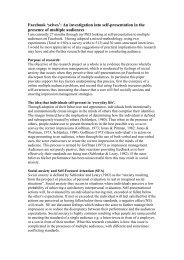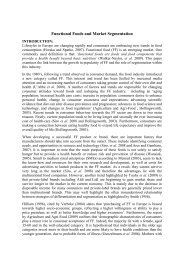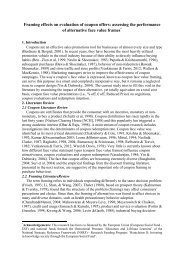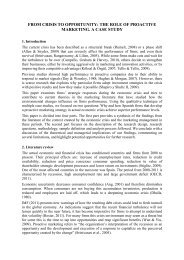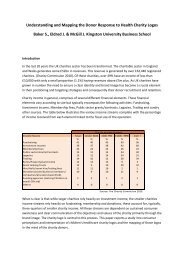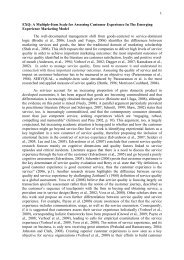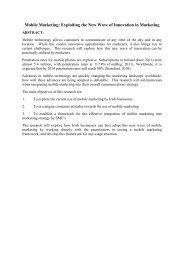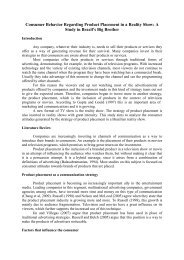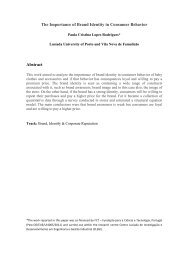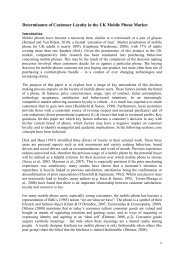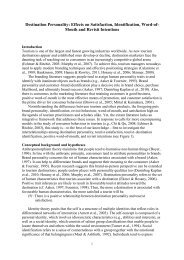Product Placement in Movies - Academy of Marketing
Product Placement in Movies - Academy of Marketing
Product Placement in Movies - Academy of Marketing
You also want an ePaper? Increase the reach of your titles
YUMPU automatically turns print PDFs into web optimized ePapers that Google loves.
appeals less favourably. Similar results on the dimension performance orientation were found <strong>in</strong> Diehl,<br />
Terlutter and Mueller’s (2008) study. It is likely that <strong>in</strong>dividuals with different cultural orientations<br />
will respond differently to prom<strong>in</strong>ently placed brands.<br />
Consumers’ attitude toward product placement <strong>of</strong> different product characteristic is seldom<br />
explored <strong>in</strong> previous literature (Tiwsakul, Hackley and Szmig<strong>in</strong> 2005). McCarty (2004) po<strong>in</strong>ted out<br />
that it is important to <strong>in</strong>vestigate what type <strong>of</strong> product/brand could benefit more from product<br />
placement. Respondents <strong>in</strong> McKechni and Zhou’s (2003) study reported that they are less likely to<br />
notice a placed brand if they are not familiar with it. It is possible that a well-known brand will be<br />
more persuasive than an unknown brand if placed <strong>in</strong> movies. Pae, Samiee and Tai (2002) suggested<br />
that well-known brands with transformational appeals were more successful <strong>in</strong> assertive and<br />
performance-oriented culture (such as HK). It is because well-established brands are synonymous<br />
with excellence <strong>in</strong> performance and success. In other words, cultural orientation may moderate the<br />
effect <strong>of</strong> brand awareness on perceived brand effectiveness.<br />
Currently movie producers are not obligated to notify audience for any upcom<strong>in</strong>g placed<br />
brands <strong>in</strong> the movie. Recently, the EU is consider<strong>in</strong>g pass<strong>in</strong>g a law which requires movie producers to<br />
announce product placements at the beg<strong>in</strong>n<strong>in</strong>g <strong>of</strong> the movie (Eisend, 2009). Previous studies <strong>in</strong>dicate<br />
cultural differences with respect to regulat<strong>in</strong>g product placement. Viewers <strong>in</strong> an assertive culture, the<br />
US, generally do not th<strong>in</strong>k that it should be banned or regulated by the government (Sung, Gregorio<br />
and Jung 2009) whereas respondents from a less assertive culture, S<strong>in</strong>gapore, agreed that the<br />
government should regulate the use <strong>of</strong> branded products <strong>in</strong> movies (Karrh, Frith and Callison 2001).<br />
Therefore it is believed that the two cultural dimensions “assertiveness” and “performance<br />
orientation” identified by House, Hanges, Javidan, Dorfman and Gupta (2004) will moderate the<br />
relationship between placement characteristics and placement effects.<br />
Research <strong>in</strong> consumer behaviour and social psychology proposed that effortlessly evaluat<strong>in</strong>g<br />
message arguments and product attributes is unlikely to happen (Petty and Cacioppo 1981). The<br />
elaboration likelihood model (ELM) is widely used <strong>in</strong> previous literature to understand how<br />
consumers process persuasive messages (Petty and Cacioppo 1986). When watch<strong>in</strong>g a movie, we are<br />
less defensive and tend to be more receptive <strong>of</strong> the presented <strong>in</strong>formation (Tsai, Liang and Liu 2007).<br />
<strong>Product</strong> placement <strong>in</strong> a stimuli-rich environment (movies) is less likely to attract defensive process<strong>in</strong>g.<br />
It is usually more embedded than traditional advertisement thus is harder to detect the persuasive<br />
<strong>in</strong>tent and activate one’s persuasion knowledge. However, a prom<strong>in</strong>ent, a priori notified placement or<br />
a placement <strong>of</strong> an unknown brand may be more likely to draw audience’s attention towards it. Their<br />
persuasion knowledge is triggered and may lead to extensive process<strong>in</strong>g <strong>of</strong> the messages (Friestad and<br />
Wright 1994; 1995). They may counterargue with the promotional content and are less likely to be<br />
persuaded. Therefore it is also hypothesized that prom<strong>in</strong>ence, brand awareness and prior notification<br />
lead to variations <strong>in</strong> placement process<strong>in</strong>g which then mediate placement effectiveness.<br />
Research Plan and Methodology<br />
The UK and HK were chosen for comparison because they are two promis<strong>in</strong>g markets for<br />
product placement. The ban <strong>of</strong> product placement on television has just been lifted <strong>in</strong> the UK. <strong>Product</strong><br />
4


